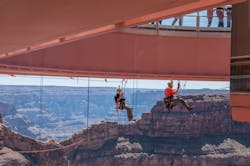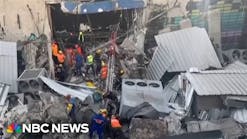What is rope access and how is the rope access industry influencing rope rescue in the fire service? The pace of change in rope rescue in the fire service has slowed in recent years, but there may be more change around the corner. The large industry of rope access has been gaining momentum, and it is influencing the fire service rope rescue culture in a number of ways.
Rope access defined
A professional rope access technician is someone who does work at height. Their job focuses on rope access techniques and equipment that allow them to work in normally inaccessible locations or areas only accessible by cranes, for example. Today you see welders, structural inspectors, mechanics and workers of all types using rope access tools and techniques to do their jobs safely and more cost effectively than in the past.
Rope access is a growing industry that is driving the development of specialized gear. The gear and the techniques have not gone unnoticed by fire rescue instructors and practitioners. Can we do rescue faster and safer with tools and techniques from the rope access industry? The answer is probably yes.
Organizations and certifications
First, let’s take a deeper look at rope access. The first professional rope access organization was the Industrial Rope Access Trade Association (IRATA). IRATA was formed in the late 1980s in the United Kingdom to support the offshore oil and gas industry. IRATA has trained more than 100,000 rope access technicians worldwide, and was a driver in the development of international standards and regulations in the rope industry.
The Society for Professional Rope Access Technicians (SPRAT) was formed in North America in the mid-1990s. SPRAT has been a driver in the development of standards and regulations in the United States and Canada.
SPRAT and IRATA are very similar in that they both define certification and training requirements. I will focus on SPRAT, as it is the primary organization here in the U.S.
There are three levels of certification for a rope access technician.
Level I is the beginning level and is considered a general worker like a firefighter. Level I training is typically about 5 days of classroom time on rope instruction, with the fifth day as an evaluation and certification day. The evaluation is a test of knowledge and skills covering about 20 topics.
The evaluator is a third-party SPRAT-certified evaluator who is brought in for the evaluation day and who is primarily concerned with seeing safe and proper technique. The rope access techniques are physically and mentally demanding, and there are always some people who do not pass the first evaluation.
The core skills of the rope access technician revolve around ascending and descending a main rope while using a second adjacent rope for a self-belay or backup. Techniques including transferring from one rope system to another rope system and rescuing another person on rope are evaluated. Of course, being able to climb the structure with a safe fall arrest system while maintaining 100 percent contact is also a key skill.
After certification at level I, a rope access technician needs to log their time on rope, working and training. After 500 hours of logged on-rope time, a level I technician can take the evaluation for level II. A level II technician is responsible for a few more skills and greater knowledge and leadership, and is ultimately considered a lead technician on the worksite.
As part of the level II evaluation, a rope access technician has to perform all of the level I procedures and then climb up a system that a victim is on and rescue them—a process that involves getting them lifted off their ascender. They also need to complete another rather complicated rescue procedure of a worker on line called a pitch head.
A level II technician can take the test for a level III after 1,000 hours of logged time on rope. A current level III technician must sign off all logged time. A level III technician is responsible for the worksite operations, the site hazard analysis, and is considered the supervisor. The level III evaluation includes more in-depth evaluation of the candidate’s knowledge and critical-thinking skills. The level III candidate must perform more difficult individual rescue procedures, and they must plan and lead several team operations, including a high-line rescue.
Each level of rope access certification is good for 3 years, whereupon the technician must recertify.
Influence on the fire service
Fire service technical rescue and rope access share the common basis of using life safety rope for protection, access and retrieval. However, rope access techniques focus on individual skills that go far beyond just rappelling and a rescuer-based pick-off.
After completing the basic rope access certification, an individual has what I would consider to be an advanced competency level for working at height. This is a confidence level allowing a rescuer to move up or down, laterally and transitioning from one rope system to another while maintaining two points of contact at all times.
Where the fire service technical rescue team tends to deploy a fairly large group for everything, we are seeing that in some cases, a rope access worker can accomplish a similar task quickly and safely with just one person. An example of this is a structural tower-rescue scenario. A rope access approach would send a rescuer up using a dual lanyard fall protection system. They would set two ropes above the victim and bring the victim down with a pick-off using a Petzl ASAP as a backup for both. The whole procedure might be done in less than 10 minutes.
Another influence of rope access on the rescue industry is changing equipment. You are now seeing a host of new efficient devices, harnesses and ropes developed for industrial rope access, but that are also very useful to any person who works at height, including a technical rescue technician.
For example, the Petzl ASAP is a device designed to work as a personal belay or backup. This device uses an inertia brake that allows the device to move on the rope (or rope move in the device) freely, but when the rope moves faster than about 2.5 meters per second (mps), it automatically locks and arrests the fall. Remember, initial gravity acceleration is 9.8 mps2. The ASAP proved to be so reliable and easy to work with that it is used as the belay for a rescuer and victim in a pick-off.
Technical rescue teams saw the advantage and safety of an automatic device like the ASAP and began experimenting with it as a main belay at the anchor for litter raising and lowering operations. Petzl saw the need for this application, and after testing, has just approved the ASAP with an approved energy absorber for use at the anchor with up to 550-lb. loads.
This is exciting to the rescue community because a device like the ASAP does not rely on human reaction time like many other devices or the widely used tandem Prusik belay. The ASAP and absorber at the anchor for a belay make rescue safer.
I recently spoke with DJ Walker, a lieutenant with the Austin, TX, Fire Department (AFD) and the chair of the Technical Rescue Committee for the AFD Special Operation Division. Austin Technical Recue Team members have always had strong personal rope skills, but they are now using the ASAP as the primary belay device for rappelling and ascending, and have found that personal rope operations are safer and more efficient.
Walker said he could see rope access having an influence on the fire service. “While rope access workers and technical rescue programs are similar, we have different missions,” he said. “I do think that as rescuers see the very high level of rope skills that rope access workers have, it will raise the bar and motivate technical rescue teams to increase their personal skills.”
I also spoke with Russell McCullar II, who runs the technical rescue training program for the Mississippi State Fire Academy. Like Walker, McCullar saw the advantages of the rope access philosophy years ago and is now certified as a level III SPRAT rope access technician. He too sees rope access playing a role in technical rescues. “I think the rope rescue technician of the future will look a lot like a rope access technician with more modern personal rope tools, like a harness-mounted ascender, a handled ascender and various lanyards,” he said, adding that this just gives the rescuer more versatility.
The certification model
I have been involved in rope rescue work for 30 years, and I have seen tools and techniques come and go, but what I hope to see is for the fire service to develop a similar standardized certification process for all of technical rescue. Technical rescue has evolved into so many disciplines that it is a real challenge for rescue teams to keep individual skill competency at a defined level.
SPRAT is a good example of a parallel industry that is out in front of skill standardization and certification. This is not to say that the fire rescue service is falling behind, as I know that we have a huge number of very competent rescue technicians. It’s just that we as an industry didn’t do a good job of defining what our performance expectations were, with these expectations largely being left up to the individual authority having jurisdictions. We trained a lot of rescue technicians in just the past 10 years, but I think most teams have found that an even bigger challenge has been to keep up their skills.
What’s next?
I think we in the fire service can look at the rope access community and maybe borrow some of the things that make them so safe and successful. We can easily use the new tools that are evolving out of industrial rope access, but maybe we can come up with a national technical rescue certification model based off of NFPA 1006 (2017 edition): Standard for Technical Rescue Personnel Professional Qualifications. Certification and re-certification based on defined performance criteria might make things easier for everyone.
Sidebar: Where to Get SPRAT Training
SPRAT training is available through a number SPRAT member organizations around the United States and Canada. Most of these companies are active contractors in industries practicing rope access techniques, and they also offer classes. The good news is that a typical training facility is a veritable jungle gym of rope and structural props. Most provide all the gear you need—and some even provide food.
Expect to spend five very physical days on rope getting a good abdominal workout as well as a mental workout. Also expect to pay about $1,500 for the class and up to $500 for the third-party evaluation. Visit sprat.org to look for a training company near you.
After getting certified as a level I rope access technician, you can work in the industry, and many of the companies that conduct training also recruit students to be part of their rope access team. This is not bad side work for rescue technicians. What is more practical, though, is to consider how some rope access skills and techniques might be applied to some new personal rope skills training for your team.
Tom Pendley
Tom Pendley recently retired as the deputy chief of operations and special operations with the Peoria, AZ, Fire Department. He is now doing private consulting. Pendley is the author of The Essential Technical Rescue Field Operations Guide and the technical rescue chapter in the International Association of Fire Chiefs’ book Chief Fire Officer’s Desk Reference. He is a certified SPRAT level I rope access technician.
Connect with Tom






